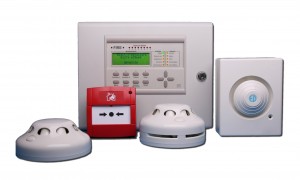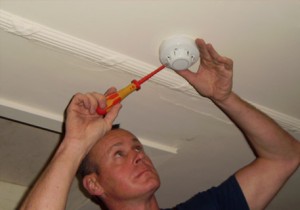Fire Detection Systems
December 31, 2012 by Jordan Morgan
Filed under Family and Personal, Home Improvement, Home Insurance
Fire Detection Systems
An automatic Fire Detection Systems is designed to detect the unwanted presence of fire by monitoring environmental changes associated with combustion. In general, a fire alarm system is classified as either automatically actuated, manually actuated, or both.
Automatic fire alarm systems are intended to notify the building occupants to evacuate in the event of a fire or other emergency, report the event to an off-premises location in order to summon emergency services, and to prepare the structure and associated systems to control the spread of fire and smoke.
A smoke detector is a device that detects smoke, typically as an indicator of fire. Commercial, industrial, and mass residential devices issue a signal to a fire alarm system, while household detectors, known as smoke alarms, generally issue a local audible or visual alarm from the detector itself.
Choosing a smoke alarm and installing it
Choose a smoke alarm that complies with the British Standard (BS EN 14604:2005) and carries the British Standard Kitemark or LPCB ‘Horseshoe’ mark.
- Always put Fire Detection Systems where you will be able to hear them throughout the home, particularly when you are asleep or when doors are closed.
- If your home has only one level (storey), fit the Fire Detection Systems between the living area and bedrooms.
- If your home has more than one level (storey), fit one Fire Detection Systems at the bottom of the staircase and further alarms on each landing.
- Fit Fire Detection Systems on the ceiling, as near as possible to the centre of the room, hallway or landing. The Fire Detection Systems should be at least 30cm (12 inches) away from any wall or light fitting.
- Make sure you can reach your Fire Detection Systems easily to test it each week – avoid fitting it directly over a staircase.
- Follow the manufacturers’ instructions on how to fit your smoke alarm and change the battery.
Where not to fit your smoke alarm
- Don’t fit your smoke alarm in or near to the kitchen or bathroom as it could be set off accidentally by cooking fumes and steam.
- Don’t fit your smoke alarm in a garage where it could be set off accidentally by exhaust fumes.
- Don’t fit your smoke alarm on damp or dusty surfaces or false ceilings as there is a risk it will fall down.
Battery-powered detectors
Never remove the battery from your detector even for a short period, remember the detector is only doing its job.
Most budget smoke detectors will come with a battery ready fitted. This battery will last you for at least one year. Make a point of changing that battery annually. Consider using one of your children’s birthdays, or a special occasion, to remind you to change it.
More expensive long life detectors are now available and if you are intending to stay in your house you should consider purchasing one of these.
Mains-powered detectors
You may wish to consider a mains powered detector, they operate under normal circumstances using power supplied from the mains. In the event of a power cut, a pre-installed battery takes over to ensure you are always protected. These systems use very little electricity and alleviate the problems of flat batteries.


